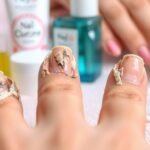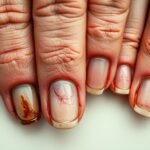Ever wondered why your nails hurt? This common issue can be a minor problem or a sign of deeper health issues. Nail pain, or onychalgia, affects many and can come from different sources. Let’s explore the world of nail health and find out why fingernail discomfort happens.
Your nails are more than just for looks. They’re made of keratin and take up to six months to fully grow back. Health problems can slow this growth, causing pain and abnormal looks. While most nail pain is easy to fix, some signs might mean a bigger health issue.
Nail pain can come from simple injuries or serious health problems. You might feel sharp pain from an injury or ongoing discomfort. Issues like nail growths, deformities, diseases, and injuries can all cause pain.
Healthy nails should be shiny, pink, and feel good. If your nails hurt a lot, look different, or you have other symptoms like fever or swelling, see a doctor. Your nail health can tell you a lot about your overall health.
Key Takeaways
- Nail pain can be acute or chronic with various causes
- Nails take up to 6 months to regrow completely
- Most nail pain is temporary and treatable
- Persistent pain or changes in nail appearance warrant medical attention
- Nail health can reflect overall body health
- Professional care is crucial for proper diagnosis and treatment
Common Causes of Nail Pain
Nail pain can come from many sources. It can be from small irritations or serious infections. Knowing what causes it can help you fix toenail aches and stop them from getting worse.
Nail Infections (Paronychia)
Paronychia is an infection around your nails. It makes the skin swell, turn red, and hurt. Sometimes, you need antibiotics or steroids to treat it.
Fungal Nail Infections
Nail fungus can make your nails turn yellow, get thick, and split. If home treatments don’t work, you might need stronger medicine or even have your nail removed.
Ingrown Nails
Ingrown nails happen to 2.5 to 5 percent of people. They occur when the nail grows into the skin, causing pain and swelling. If the pain doesn’t go away or gets worse, see a doctor.
Physical Injuries
Nail injuries can happen from cutting, tearing, or smashing. They can cause bruising, bleeding, and pain. Small injuries might heal at home, but big ones need a doctor’s help.
| Injury Type | Symptoms | Treatment |
|---|---|---|
| Bruising | Subungual hematoma, throbbing pain | Draining blood if severe |
| Laceration | Bleeding, pain | Stitches, special materials for nail bed |
| Avulsion | Partial or complete nail loss | Removal of remaining nail, protection of nail bed |
How long it takes for nails to heal varies. Fingernails grow back in 4-6 months, while toenails take up to a year. New nails might have grooves or ridges. If you feel more pain, swelling, or fever, see your doctor right away.
Why Do My Nails Hurt: Exploring Underlying Factors

Nail pain can come from many sources. It can be from small injuries or serious nail problems. Knowing what causes your pain helps you find the right treatment.
Nail trauma is a big reason for pain. If you’ve hurt your nail, you might see blood under it. This pain usually goes away in a few days. But, if it’s very bad, you might need to see a doctor.
Jobs that involve a lot of hand washing can harm your nails. Hair stylists and healthcare workers often have brittle or soft nails. This can make your nails hurt and more likely to get injured.
Changes in nail color can mean there’s a problem. Brown or black lines in nails, called melanonychia, are more common in African Americans. They can be caused by many things. Yellow nails often mean you have a fungal infection. If not treated, this can hurt.
| Nail Appearance | Possible Cause | Action Required |
|---|---|---|
| Horizontal ridges (Beau’s lines) | Kidney or thyroid disease | Consult doctor if on multiple nails |
| White spots | Minor injury or deficiency | Check with doctor if persistent |
| Brown coloring under nail plate | Potential serious condition | Immediate dermatologist consultation |
| Black lines | Tiny clots or psoriasis | Seek medical evaluation |
If your nail pain doesn’t go away or if you see strange changes, see a doctor. A primary care doctor or dermatologist can help. They can figure out what’s wrong and treat it, keeping your nails and health good.
Nail Abnormalities and Their Impact on Pain
Nail problems can be very painful. They come from genetics, diseases, and outside factors. Knowing about these issues helps in treating and managing pain.
Genetic Factors
Some nail problems are passed down in families. For example, clubbing of the fingertips can be inherited. It might not be serious but can still cause discomfort and affect nail growth. Getting special care is key to managing pain and avoiding further issues.
Disease-Related Abnormalities
Diseases can also cause nail problems and pain. Psoriasis often leads to nail damage. Kidney failure can cause nails to turn half-white, half-brown. Cirrhosis results in Terry’s nails, with a white area and red tips.
- Koilonychia: Linked to iron deficiency anemia
- Leukonychia: White streaks or spots caused by medication or disease
- Beau lines: Horizontal depressions due to illness or injury
External Factors Causing Abnormalities
Things around us and our habits can also harm our nails. Picking at nails can lead to median nail dystrophy. Aggressive manicures can damage them too. Infections from fungi, bacteria, or viruses can change how our nails look and hurt.
| External Factor | Potential Nail Abnormality | Impact on Pain |
|---|---|---|
| Poor-fitting shoes | Ingrown toenails | Moderate to severe pain |
| Nail-biting | Paronychia | Inflammation and tenderness |
| Chemical exposure | Brittle nails | Splitting and breaking causing discomfort |
If you have ongoing nail problems or pain, see a doctor. They might suggest treatments like antifungal meds or tests to find the cause. Early action can stop long-term damage and ease pain.
The Connection Between Nail Care Practices and Pain
Your nail care routine is key to avoiding pain and keeping your nails healthy. Good nail hygiene is a must. But, some professional treatments can hurt if not done right. Knowing how different nail care practices affect you can help you avoid pain and keep your nails in great shape.
Aggressive manicures or pedicures can hurt. For example, filing the nail too much can make it sensitive. Thin or weak nails might hurt more during nail work. Make sure your nails are healthy before getting any enhancements.
Be careful with gel products. Overcured gel can cause heat spikes and harm your nail bed.
To lessen pain, moisturize often and choose gentle treatments. If nail pain persists, see a healthcare expert. They can find out if you have a nutrient deficiency or allergy causing the pain. Eating well, with lots of fruits, veggies, and whole grains, helps your nails by giving them important vitamins and minerals.
When picking professional nail treatments, think about less damaging options. Gel polish or dip powder nails might be better for sensitive nails. Always talk to your nail technician about any pain or sensitivity you feel. By focusing on good nail care and choosing the right treatments, you can have beautiful nails without pain.
FAQ
What are the common causes of nail pain?
Why do my nails hurt? What underlying factors could be responsible?
How do nail abnormalities contribute to nail pain?
How can nail care practices affect nail pain?
When should I seek professional help for nail pain?
Source Links
- Nail Pain? Free 3-Min Quiz Identifies Causes | Ubie – https://ubiehealth.com/symptoms/nail-pain
- Why Do My Nails Hurt? Causes, Symptoms, Treatments – https://www.healthline.com/health/why-do-my-nails-hurt
- 7 Possible Causes of Pain Under Fingernail When Pressed – https://www.healthline.com/health/pain-under-fingernail-when-pressed
- Nail injuries: MedlinePlus Medical Encyclopedia – https://medlineplus.gov/ency/patientinstructions/000800.htm
- What Your Nails Tell You About Your Health – https://www.nkch.org/blog/what-your-nails-tell-you-about-your-health
- 6 Things Your Nails Say About Your Health – https://health.clevelandclinic.org/6-things-your-nails-say-about-your-health
- Nail abnormalities Information | Mount Sinai – https://www.mountsinai.org/health-library/symptoms/nail-abnormalities
- Nail abnormalities – https://www.nidirect.gov.uk/conditions/nail-abnormalities
- Why Do My Nails Hurt After Getting Them Done? – Paola Ponce Nails – https://paolaponcenails.com/why-do-my-nails-hurt-after-getting-them-done/
- Nail Health Chart: Common Problems and Treatment – https://www.healthline.com/health/beauty-skin-care/healthy-nails
- Contact Dermatitis and Acrylic Nails: Causes and Solutions – https://www.beckerentandallergy.com/blog/contact-dermatitis-and-acrylic-nails








Interesting read, but dont you think blaming nail pain on infections is oversimplified? What about poor diet or lack of nutrients? Just a thought.
Interesting article, but is anyone else questioning why were not discussing the impact of diet on nail health? Just a thought.
Interesting read, but isnt it curious how we dont talk about the psychological aspect of nail pain? Mind over matter, anyone?
Mind over matter doesnt quite hold up when youve stubbed your toe in the dark!
Guys, ever wonder if nail pain is just an evolutionary reminder not to use our hands as tools? Just a thought. 🤔
Interesting read, but why ignore the role of diet in nail health? Isnt that just as influential as infections?
So, what about nail pain from acrylics? This article seems to ignore the plight of us nail art lovers!
Interesting read, but isnt it possible that nail pain could also signal underlying conditions like heart disease? Why no mention of that?
Interesting read, but arent we overcomplicating this? Ever thought nail pain might just be from hitting your thumb with a hammer? 🤷♂️😂
Interesting read, but wouldnt soaking nails in beer combat fungal infections? Yeast kills yeast, right? Just a wild thought. 🍻
Interesting read! But arent we overlooking the role of diet in nail health? Wouldnt more focus on nutrition solve these issues?
Interesting read, but arent we ignoring the elephant in the room? What about the impact of diet on nail health, huh?
I think were missing a big point here, guys. What if the real solution is just to stop wearing tight, uncomfortable shoes?